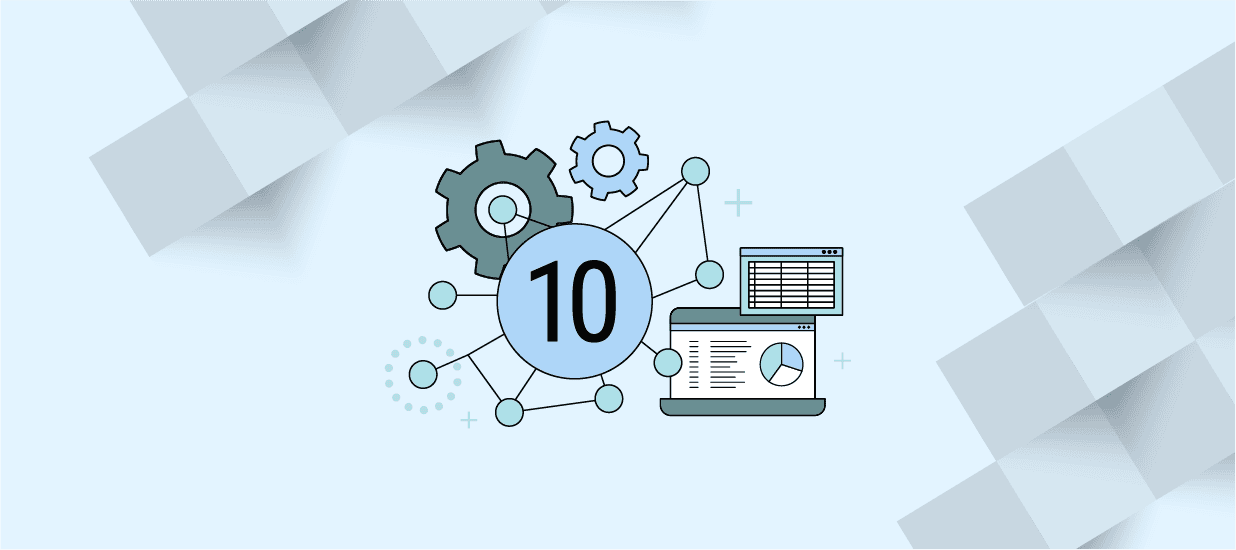Can you leverage data to gather intel, develop strategy and build a stronger business? Yes, you can, and this article tells you how to do it.
Data is everywhere and companies are collecting more of it than ever before. While companies are surrounded by a sea of data points and equipped with powerful tools designed to leverage that data, many organizations struggle to unlock the power hidden in all that information.
Leveraging data might be the secret to success for everything from marketing to product development, but it’s not that simple. Not all businesses use data in the same way or for the same purpose. Many organizations struggle to simply collect, analyze and leverage data to build a solid business tragedy.
What does it mean to leverage data, what data should you be gathering, and how can you use it to make better, data-driven decisions?
How to Leverage Data
Leveraging data involves the strategic use of data in order to improve business and gain a competitive advantage. It involves analyzing data from a variety of sources to measure performance and process, set strategic goals, and guide improvement. Effectively leveraging data not only involves collecting and analyzing data points, it also requires companies to act on the insights from that data.
Ways to Leverage Data
Although “data” can be a buzzword, it’s important to recognize that data is not a one-size-fits-all solution to business problems. Not only do organizations have different needs, they collect different types of data points as they operate. This data can be used for a variety of purposes depending on the nature of the information and the needs of the organization.
Data collected by a business can be used in many ways, including to:
- Identify customer preferences and trends. This could enable the tailoring of products and services to better meet market demands.
- Inform marketing strategies and the allocation of resources. This might include segmenting audiences into different groups based on their purchase or usage data.
- Understand user behavior. User behavior, including user experience data, could provide insight into how customers interact with a product or service.
It’s important to understand that data can only support the business, it cannot change it. Organizations must start with a solid understanding of their business goals before they can leverage data to achieve them.
Using Data to Build Business Strategy
Every company can leverage data to build a business strategy as long as they understand their goals and know what data they need to achieve those goals. This sounds simple, but it is not always as straightforward as it may seem. Furthermore, a successful business strategy should encompass all parts of the business. This means that you must also use data that represents all parts of the business, but that data might serve a different purpose in the overall picture of your organization’s strategy for success.
Let’s use a healthcare system as an example. Healthcare systems need to serve their existing patients and market to new patients. A marketing-focused data strategy might focus on building a customer database and tracking customer interactions. It might also focus on leveraging data insights to inform marketing investments. At the same time, a health-improvement data strategy might focus on codifying patient data to better identify health patterns in a population and proactively allocate resources to serve those populations.
Turning Data into Insights
You have to check off many boxes in order to transform information into an actionable strategy. First and foremost, you have to know what data needs to be collected, how to collect it, and it has to be accurate and reliable. You have to understand which audiences need the data and how to offer it to them in a way that is meaningful and actionable. And of course, you must determine how to integrate analytics seamlessly into daily workflows to ensure that everyone has access to the information and is moving toward the same goals.
If it sounds like a lot, it is. But you can start with these three crucial steps to help you turn data into insights and strategy in your organization:
Focus on Data Quality
When analyzing business data, it’s important to start with quality data. Data quality is the measure of how well-suited a data set is to serve its specific purpose. Measures of data quality can include the completeness, uniqueness, and timeliness of the data collection. Quality can also reflect the accuracy, consistency, and validity of the data. Essentially you want to ask if the information is correct and does it measure what you want it to measure? Is it representative of your business or target audience? And could the data be replicated in the future?
It’s always a good idea to work to improve data quality, and there are many ways to approach this depending on the type of data your organization collects. For instance, if your data is spread across multiple files, it may be better to consolidate it at the source or plan for regular maintenance. Another example would be to ensure that customer information such as phone number, email address, and physical address (i.e. city, state, and ZIP code), is consistently formatted. These may seem like small measures, but can significantly improve the quality and usability of your data.
Tailor Data to Your Audience
How you share data is almost as important as the data you share. Before creating a platform to provide insights, you need to know who will use the information and what their main objectives will be. This is important because users have different priorities when it comes to data.
For example, C-level executives may only be interested in the big picture of how the organization is performing. At the same time, managers may focus on data that provides insight into specific business drivers. Similarly, analysts may prefer to explore data independently while general data users may only be interested in information related to their specific area of business.
Maintain Data Workflows
To ensure that your analytics system is widely used, you should consider how your users will integrate it into their daily workflow. Don’t underestimate the importance of this step. This will have the greatest impact on your business intelligence or analytics program.
You can make the adjustment easier for future users by embedding analytics into an existing system. This can eliminate the need for manual data collection and entry, streamline processes, and make it more likely that your users will take advantage of the insights available. It also reduces resistance and makes it easier to get everyone on board!
Data Sources for Business Strategy
Leveraging data can be a daunting task for any organization. Data can come from a variety of sources, from customers to competitors and just about everywhere in between. This data can be analyzed separately from other sources or integrated to create a more nuanced picture of your business’s place within the market.
It’s important to explore the types of data you can derive from internal and external sources as well as the benefits and drawbacks connected with using that data.
Leveraging Internal Data Sources
- Customer Data. Customer data can take a variety of forms, including customer purchase history, demographics, and feedback data (such as CSAT or NPS scores). Using customer data helps drive personalized marketing and audience segmentation, improves customer experience, and can drive retention. However, this comes with concerns about privacy and data accuracy, as well as obtaining consent for data collection and usage. It’s important to follow all privacy laws when handling consumer data.
- Financial Data. Financial data relates to the company’s finances, including debts and income. This may include income statements, cash flow statements, or financial forecasts. Leveraging financial data can support strategic financial planning, budgeting, and risk management for your company. Some drawbacks to using financial data include data accuracy and limited access to comprehensive data. This could impact the accuracy of financial forecasts and may present obstacles to complying with financial regulations.
- Employee Data. This may include employee performance records, HR surveys, payroll data, or training history data. Companies can leverage employee data to support human resources decision-making, manage and retain talent, and engage employees. There are some disadvantages to collecting and using employee data. Specifically, companies should always protect employee privacy and anonymity, and make sure that they are complying with labor laws.
- Social Media Data. Social media data can be gathered from on-platform content such as comments on your company’s posts, organic posts created by other users, reviews, and more. With social media, you can leverage real-time customer engagement to analyze sentiment, monitor mentions of your brand, and execute targeted advertising. Although it can be difficult to identify relevant conversations and manage the high volume of interactions on social media, it can provide a rich source of data to leverage.
- Web Analytics Data. Web data can include website traffic, conversion rates, and user experience data. Deriving insights from web analytics data can support website optimization, enable companies to segment customer experiences on their website, and reinforce the effectiveness of digital marketing. There are some drawbacks to using web analytics data. It can be difficult to track user interactions between sites, or as users come to the website from different marketing channels.
- IoT (Internet of Things) Data. IoT refers to when physical objects are equipped with sensors, software, and other technology that connects and exchanges data. IoT data could include sensor data, machine performance metrics, GPS data, or temperature readings. This enables real-time monitoring of products, predictive maintenance, and process optimization. Although IoT enables rich business data, managing such large volumes of data, storing, and processing that data, and ensuring data security and privacy can be a challenge.
Leveraging External Data Sources
- Market Data. Market data can include surveys, focus groups, industry reports, and competitor research data. Using market data can inform strategic decision-making and fuel competitive intelligence. It can also help your company proactively identify market trends. One drawback to using market research data is that it is costly and time-consuming to collect, which makes it difficult to stay up to date on market trends. Additionally, possible bias from the sources and methodologies can make it difficult to accurately interpret research findings.
- Competitor Data. Like market data, competitor data is essential to any business strategy. Companies can leverage competitor data such as pricing information, product features, market share reports, and customer reviews to benchmark their own performance, conduct competitive analysis, and identify market opportunities based on unaddressed market problems.
- Supply Chain Data. Supply chain data may include shipping records, inventory levels, supplier performance metrics, and demand forecasts. Leveraging supply chain data can improve efficiency, drive cost reductions, and enhance demand forecasting. On the other hand, supply chain data collection from supplies may be inconsistent or delayed. Additionally, it may be difficult to integrate complex supply chain data from a variety of sources.
- Government and Public Data. Public data can include economic indicators such as GDP or employment rates, government census data, and regulatory filings. Leveraging public data can inform market entry or exit decisions, regulatory compliance, and economic trend analysis. Some drawbacks to using government and public data include the risk of outdated or incomplete data, as well as challenges to validating the accuracy of the data or difficulties of customizing the data.
The Challenges of Leveraging Data
Companies are gathering more data than ever before and in turn, looking for ways to leverage that data so they can make better business decisions. There are, however, challenges when it comes to data, starting with the logistics. It is challenging to gather, organize, and safely store large volumes of data. There are security, privacy, legal, and regulatory concerns to consider which can be difficult and expensive to navigate.
Once you have everything in place to effectively and safely collect and store data, there are still challenges. From a data engineering standpoint, integrating data from different sources is a complex and time-consuming task. Siloed data and organizational resistance to using data can further hinder the leveraging of data.
In the past only certain industries were overly interested in leveraging data, but that’s not the case now. Every type and size of company has the ability to collect, analyze, and utilize data to improve their business strategy. Small businesses can use online analytics to attract more business and streamline offerings. Dating apps can analyze user profiles and behavior data to determine matches and place the ads you can see when you swipe.
For any organization to continually leverage data, it’s important to invest in data infrastructure, analytics tools, and skilled team members. As Natasha Joslin, co-founder of data agency Mojo, shares in our Data Chats podcast, bridging the gap between data and business teams remains a significant challenge for any company. This comes down to commitment to data training and working to become a more data-driven organization.
Author
-

The Pragmatic Editorial Team comprises a diverse team of writers, researchers, and subject matter experts. We are trained to share Pragmatic Institute’s insights and useful information to guide product, data, and design professionals on their career development journeys. Pragmatic Institute is the global leader in Product, Data, and Design training and certification programs for working professionals. Since 1993, we’ve issued over 250,000 product management and product marketing certifications to professionals at companies around the globe. For questions or inquiries, please contact [email protected].
View all posts








